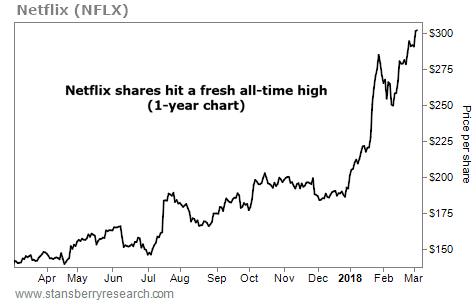| Home | About Us | Resources | Archive | Free Reports | Market Window |
How to 'Call' the Markets CorrectlyBy
Tuesday, March 6, 2018
"Steve's been one of the very few who's been really right this cycle," Meb Faber said about me on his latest podcast episode.
"There's a speech he gave at the New York Stock Exchange in like 2012, where he outlined [his "Melt Up"] thesis, and he's been right."
Meb is the chief investment officer of Cambria Investment Management. He does fantastic homework about what works in investing. And he and I separately came to the same conclusions. (I strongly recommend listening to his podcast and reading his books if you are REALLY into investing.)
What I'd like to share with you today is my big secret...
It's how I've correctly called the U.S. stock market since 2009.
And it's how I make ALL my market calls... whether it's stocks, real estate, commodities... you name it.
The secret is simple. I follow two basic ideas...
Let me briefly explain both of these, starting with the simple setup I look for... Meb said on his podcast, The Meb Faber Show, "[Steve] always says his favorite investments are cheap, hated, [and] entering an uptrend. That's where we originally intersected years ago, and why we kind of see eye to eye on a lot of things."
Contrary to most everyone on Wall Street, Meb and I came to the same conclusion years ago about what works in investing:
Value investing is buying what's cheap – what's "on sale." Momentum investing seems like the opposite. You are buying what's in an uptrend – what's "going up." Because these strategies feel so opposed, most folks on Wall Street are firmly in one camp or the other (value or momentum).
Since Meb and I believe that BOTH strategies work, we discovered that we were basically Wall Street outsiders. Somehow, there's an unwritten law that you can't believe in both... It's like saying you're a Christian and a Muslim at the same time.
The thing is, the math is clear. Both strategies work. It's plain as day. And these are not competing ideas. Here's what you need to know:
Astoundingly, the basic idea of finding what's cheap, hated, and in an uptrend works across most asset classes. (The challenge sometimes is figuring out how to define "cheap" and "hated" in some assets.) In 2009, in the U.S. stock market, this simple setup was in place. Stocks were cheap and in an uptrend. And they were hated, too... No one else was interested.
So back then, I needed to decide on "one thing that matters" to the markets.
When I invest, I want to find the one thing that matters to the markets at that moment... If you can isolate the one thing that matters, you can more easily block out the daily "noise" in the markets and stay invested.
I decided "the one thing" that mattered back then was interest rates...
My working script was this: The Fed would keep interest rates lower than anyone could imagine, for longer than anyone could imagine. And that would drive asset prices (like stocks and real estate) higher than anyone could imagine.
That was my "one thing." And that one thing kept me in the markets all these years. Heck, rates are still relatively low today.
So where are we today? Look to the lessons of this message...
So if you are in stocks today, you are in because of No. 1 – the trend.
Stay in stocks. And if the trend goes away, then see No. 2...
Good investing,
Steve
Further Reading:
"To make money, you need to have conviction in an idea," Steve writes. In this classic essay, he explains the advantages of knowing "the one thing," and how focus can improve your investing. Read more here.
Market NotesA 'FANG' STOCK IN A HUGE UPTREND Today, we're checking in on one of the market's most popular stocks...
Recently, we discussed four companies that created huge technological shifts in the ways we shop, socialize, and engage with media. Today, we'll focus on one of these game changers – Internet-streaming giant Netflix (NFLX).
For about $10 a month, Netflix lets you stream thousands of films and television shows to your TV, smartphone, computer, or tablet. This business model has crushed traditional cable. In late January, the company beat Wall Street's earnings estimates... and added more than 8 million new subscribers in the fourth quarter alone. The company now boasts nearly 120 million subscribers worldwide – up 25% year over year. And today, almost one in five Americans has a Netflix account.
This massive popularity has pushed Netflix shares higher. They're up more than 350% over the past three years (versus a gain of less than 30% in the benchmark S&P 500 Index) and just hit another new all-time high. And after winning its first feature-film Oscar on Sunday night, Netflix doesn't look to be slowing down any time soon...
 |
Recent Articles
|
|||||||||||||||||



